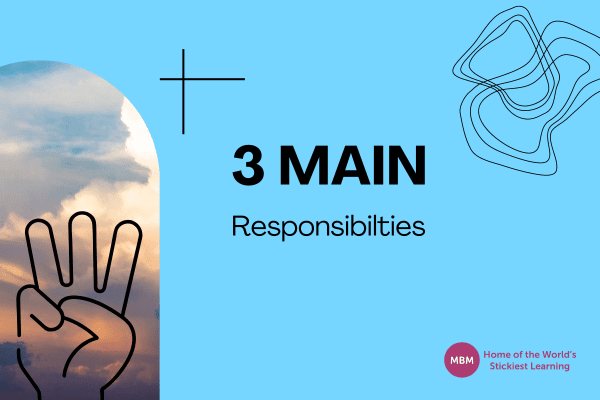Take Responsibility for Your People, Not Just the Job to Be Done
A team leader is responsible for leading their team, as the job title suggests. So far, so good. But what exactly does that responsibility involve, and how should they exercise it?
Our understanding of what a team leader is responsible for is evolving. In the UK, as businesses become less formal, leaders’ and managers’ thinking is moving further every year from classical management thinking, with its rigid hierarchies and the boss exerting task-oriented, authoritative leadership. Instead, we talk about the best leaders being people-oriented. They bring their teams with them, so they grow and have the fulfilling ‘employee experience’ talked about in growing numbers of companies’ employee value propositions.
This movement we’re seeing is, in part, due to the changing world we’re in. Businesses must navigate an environment with unpredictable external forces, including life after Brexit, Covid, the cost-of-living crisis and global instability. We don’t know what will happen next. The future is undecided. Meanwhile, the team leader’s responsibility is to see themselves and the team do the best work they can, together.

What are the 10 Responsibilities of a Team Leader?
In this article we’ll explore such important questions as what is a team leader; the 3 main responsibilities of a team leader; the difference between a team leader and a team manager; and what kind of team are you leading? From there we’ll look in detail at the roles and responsibilities of team leaders and team members, and how to judge if you’re getting there.
To start us thinking, this is the list suggested by profitableventure.com, a “give back” project for people starting businesses. They apply to any size workgroup, from two or more people to a big company:
Profitable Venture’s 10 Responsibilities of Team Leaders are:
- Strategy development.
- Vision communication.
- Evaluate performance.
- Business negotiation.
- Decision making.
- Co-ordination.
- Conduct meetings.
- Coaching.
- Serve the team.
This list looks quite random. It’s quite an assortment. And the last item, serving the team might seem out of place, particularly in task-based, regimented businesses or with temporary or casual workers coming and going, and people on zero-hours contracts.
In such environments, there needs to be a degree of discipline to get results. But profitableventure.com makes a valid point, to get the best from your people you really need to see yourself as the leader, and inspire them, not just be the boss. And so, one of your responsibilities is to serve the team members. Yes, their performance matters. But their welfare must be your utmost concern. And you must make sure they know and appreciate its importance to you.
So, What is a Team Leader?

Wikipedia says a team leader is the recognised leader of a group of people working to achieve a common goal. Workable, a website offering resources for employers with a host of HR toolkits, templates, and job descriptions, goes further and sets out how they go about achieving it. For them, a team leader is a professional in charge of guiding, monitoring, and leading an entire group. They are responsible for motivating their teammates, as well as inspiring positive communication between them so they can work together toward achieving the goals.
But let’s be clear, we’re talking about businesses here. They’re there to make profits. So, a team leader is responsible for delivering results that either they expect if it’s their business, or are expected of them by others. Or there’s no point to it.
As we said at the start, team leaders still display autocratic leadership when they need to. That’s not changed. But what HAS changed is this. Effective leadership is now widely seen as about understanding when you can give your people autonomy, and when you need to take control.
The best summary of this is Tannenbaum and Schmidt’s Continuum. Additionally, some famous autocratic business leaders are renowned for also embracing participative management and people-oriented leadership. They might loosen the reins, but they’re still leading the team.
What Are the 3 Main Responsibilities of a Team Leader?

The whole world has an opinion on this. Emeritus, a global education platform based in India, is down to earth. They say a team leader has 3 main responsibilities:
- Organising
- Guiding
- Managing others
In this analysis, a team leader needs to have a clear vision of what they want to achieve and motivate and encourage their team to reach the desired outcome. Which is fair enough. But how do you motivate people, and where does the ‘positive employee experience’ come in?
Sticky Learning ® is 7 times more effective than 1-day training courses. Plus, you will get a Chain of Evidence proving your Return on Investment. Discover soft skills training that changes behaviours long term.

You Need to Get People to See Their Work in Context…
The folks at San Francisco-based Asana, the cross-functional work platform, have a similar view to Emeritus. Like them, they say a team leader’s main responsibilities include organising. They also talk about communicating goals and connecting work to context.
This last phrase sounds somewhat baffling at first. But helpfully, another source, the Chicago-based Grossman Group, who are internal communications and leadership consultants, open it up on their blog. They say connecting work to context is important because it directly influences the quality of the processes and tasks carried out in the business and by the team. When they perceive their work context positively, says Grossman, individual employees and teams are more likely not only to be productive but to thrive.
SalesWorks Malaysia, a sales activation agency in the Far East, take it further. For them, the ‘work context’ takes in the vision and strategy which a team leader is responsible for achieving, with the help of the team. Here’s how they do that:
Vision:
A good leader defines clearly where their team is going, and how they are going to get there.
Strategy:
Leaders achieve results consistently with, and through, others, using disciplined and carefully planned processes. Effective leaders translate visions into results by focusing on the most important priorities and creating systems that empower people. Leaders create an environment, whether it’s in a small team or a big company, where people can work together and win. And there’s a strategy to it. To make the strategy happen, the leader must know how to delegate well and understand everyone’s strengths.
Talent:
A leader unleashes the ability of each person on their team to realise the vision and the strategy by improving their performance and solving problems. And, let’s not leave out, to grow their careers as a result. Leadership responsibilities include seeing others, as whole people with a body, mind, heart, and spirit. In this role, leaders move from telling people what to do and fixing problems to coaching and building capabilities and leadership in others.
The message is clear. In the past, command and control were seen as all important. People did what they were told, and respected the individual’s position and title. In today’s more fluid world, and our more people-oriented mindset, it’s more about building the business together and getting the best from your team. And that means being a leader, not just a manager.
What’s the Difference Between a Team Leader and a Team Manager?

If a potential employer asks you this question, you need to be clear. PrepInsta is a website that prepares people for job interviews. They give this answer:
- A team manager handles tasks and responsibilities and ensures that others complete their work on time.
- A team leader inspires and motivates their team members, as well as guiding and instructing them to achieve their objectives. Empathy, support, and guidance matter more than giving orders and expecting people to carry them out.
Check out our article on the difference between leadership and management for more. This brings us to another burning question…
What Kind of Team Are You Leading? Are You Management or Leadership?
We’re talking about general principles. But to apply them to your situation and get the full benefit, you need to be clear in your mind about this important question.
In 1990, John Paul Kotter argued that management and leadership have different functions. Management’s central function is to provide order and consistency, whereas leadership produces change and movement. You need both for any business to succeed. Hence in the very first list, we looked at serving the team, alongside evaluating performance and decision-making.
“The Roles of a Team Leader Are Different From Their Responsibilities.”
Let’s consider this statement.
First, here are 5 roles of a team leader:
- Manager or supervisor: Oversees all the activities in the team.
- Strategist: Decides how to approach tasks, and develops a plan to accomplish them.
- Communicator: Distributes information to team members and stakeholders – the external people depending on the team in some way or other to achieve results.
- Organiser: Keeps track of and structures the different tasks, employees and formal records.
- Goal setter: Determines the goals team members will work towards.
The roles in this list are clearly task-based. An authoritative leader who carries out these roles will achieve their goals, but there’s something important lacking. As time passes, the business is likely to grow in turnover and profitability, but the people won’t grow.
People will get better at doing their jobs as they gain experience, but they won’t develop. And if that happens, individuals may become frustrated and want to move on. Or they could burn out. Team leaders are failing in their responsibilities if they let that happen. So yes, in this instance, roles are different from responsibilities. This brings us to another list:
5 Important Responsibilities of a Team Leader

In this analysis, the team leader is responsible not just for getting results, but for developing the team. Their responsibilities come under 5 headings. For each of these areas of responsibility, there are various soft skills that you need to develop:
- Coach team members: It’s essential to appreciate the benefits of coaching, and the different coaching styles, and either do the coaching yourself or get someone to do it under your direction.
- Develop team strengths and improve weaknesses: Developing people, and understanding their motivations as explored in Vroom’s Expectancy Theory.
- Identify team goals and evaluate team progress: Having a team plan.
- Resolve conflict: Knowing about problem employees, conflicts between employees, conflicting groups, conflict resolution activities, and the attitude-behaviour cycle also known as Betari’s Box.
- Organise team initiatives: Having a team charter and managing team projects.
You can read about the different soft skills in each of these areas in the articles on our blog.
Team leaders are responsible for their teams. But for the team to make the most of their autonomy and contribute, they need to play their part. This is another kind of responsibility. Let’s explore this.
What Are 5 Common Responsibilities of Team Members?

In a project team, or a group with a specific purpose:
- Leader: The appointed leader makes sure the team has clear objectives and members are engaged. The others in the team may act as follows:
- Challenger: Questions effectiveness and drives for results.
- Doer: Encourages progress and takes on practical jobs.
- Thinker: Produces ideas and thinks through those proposed by others.
- Supporter: Eases tension and promotes harmony.
Clearly, the leader can challenge, do, think and support as well, as the situation requires.
Here’s another set of team members’ responsibilities to consider:
- Leader: Provides direction, vision, motivation, and team-building skills and creates ground rules.
- Creative director: Thinks out-of-the-box, introduces new concepts and brings fresh energy.
- Facilitator: Helps the team make decisions.
- Coach: Provides one-to-one support after training and helps with issues.
- Member: Participates in team meetings and does whatever is assigned to them.
Again, the leader can act as a creative director, coach, facilitator, or simply be a member of the team, depending on the situation. But they’re still in charge.
Effective Team Leadership – Have You Got What It Takes?

Reading this far means you have a good idea about what a team leader is responsible for. Now here’s a list of skills to work on, to be an effective team leader:
- A clear communicator.
- Strong organisational skills.
- Confidence in yourself and your team.
- Respectful to others, and open to their thoughts and ideas.
- Fair and kind.
- A person with integrity: True to your word, honest and open, someone people can trust.
- Influential in areas of technical or professional skill: You inspire others to do well because when it comes down to it, you know your stuff.
- A powerful facilitator, enabling people to develop and implement action plans.
- A skilled negotiator, solving problems, willing to listen and resolve disputes.
In our article on managing team projects, we said you know you’re doing this effectively when project teams understand their mission. We said the other signs of successful project management are:
- Individual team members know what they need to do.
- Teams are excellent communicators.
- There’s a positive team culture.
These signs also apply to more permanent teams. And in both cases, you need emotional intelligence as well. Your demeanour as team leader affects the mood and morale of the whole team. Every time someone leaves a permanent work group, the dynamic changes. And when other things happen, it’s up to you as team leader to support the team and keep people’s spirits up in the sad times, being open and there for your team. But you also need to celebrate when things go well.
How You Know You’ve Met Your Responsibilities as A Team Leader?

It isn’t just the money, honey, with sales, profits and other deliverables being achieved. Here are some other measurements of success, to look out for:
- An improved office ‘grapevine,’ with fewer rumours.
- Better morale, less negativity.
- Less conflict between individuals.
- Fewer problem employees.
- Less absenteeism and ‘presentism.’
- Employees struggling with mental health problems and personal issues are supported and helped to resolve them.
- Lower staff turnover.
- Team members show signs of leadership potential and are successfully promoted.
- Better retention of talent.
A team leader is responsible for taking charge of their team’s success. When a team leader understands their responsibilities and acts on them, people feel happy and fulfilled. Furthermore, the company’s reputation grows as a good place to work. Work on all this, and see the difference it makes.
Action: Check out our ultimate guide on Team Building Skills and Leadership Skills.




